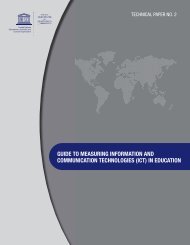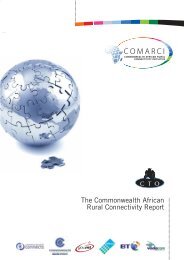Transforming education: the power of ICT policies - Commonwealth ...
Transforming education: the power of ICT policies - Commonwealth ...
Transforming education: the power of ICT policies - Commonwealth ...
You also want an ePaper? Increase the reach of your titles
YUMPU automatically turns print PDFs into web optimized ePapers that Google loves.
<strong>the</strong> schools’ initiatives by providing pr<strong>of</strong>essional advice such as technical requirements <strong>of</strong> projects or assisting<br />
schools with experimentation on emerging technologies.<br />
In addition, to building schools’ capacity in evaluating <strong>the</strong>ir <strong>ICT</strong> programs, a self-assessment rubric was developed<br />
and shared with schools. The rubric, Benchmarking Your <strong>ICT</strong> Practices for Excellence in Schools, or BY(i)TES, has<br />
been used by all schools as part <strong>of</strong> <strong>the</strong>ir schools’ annual self-evaluation exercise.<br />
4. Research and Development<br />
To promote active experimentation on <strong>the</strong> use <strong>of</strong> <strong>ICT</strong> for engaged learning, a research and development (R&D) unit<br />
was set up in <strong>the</strong> Educational Technology Division in <strong>the</strong> MOE. This unit focused on applied research works that<br />
could inform pedagogical practices in schools. Complementing <strong>the</strong> R&D unit, <strong>the</strong> Learning Sciences Laboratory<br />
(LSL), located in <strong>the</strong> National Institute <strong>of</strong> Education, was set up in 2005. Partial funding for <strong>the</strong> set-up <strong>of</strong> <strong>the</strong> lab was<br />
drawn from <strong>the</strong> research budget <strong>of</strong> MP2. LSL’s mission is “to foster deep student learning with technology-enabled<br />
pedagogical practices for cultivating twenty-fi rst century knowledge and skills through learning sciences research<br />
in Singapore schools” (http://www.lsl.nie.edu.sg/about.htm). Researchers in LSL worked with schools to explore<br />
innovative practices with <strong>the</strong> use <strong>of</strong> technology and to investigate how <strong>the</strong>se practices can be made sustainable<br />
and scalable. There were fi ve signature research models in LSL: New Literacies, Science as Systems, Ma<strong>the</strong>matics<br />
& Problem-Solving, Knowledge Building Community, and Emerging Research & Pedagogies.<br />
5. Infrastructure and Support<br />
While MP1 provided <strong>the</strong> schools with basic <strong>ICT</strong> infrastructure and equipment mainly through centralized control by<br />
<strong>the</strong> MOE, under MP2, schools had greater autonomy to enhance <strong>the</strong>ir <strong>ICT</strong> infrastructure to meet <strong>the</strong>ir varied modes<br />
<strong>of</strong> lesson delivery. Three key strategies were adopted by <strong>the</strong> schools:<br />
apple to enhance Internet access;<br />
apple to enhance <strong>ICT</strong>-enriched environments, both in schools and at home; and<br />
apple to provide greater technical support.<br />
In MP1, all school networks were connected to <strong>the</strong> MOE’s network, including Internet access. In MP2, while <strong>the</strong><br />
schools maintained <strong>the</strong> connection to <strong>the</strong> MOE’s network for <strong>of</strong>fi cial works and data communication, a separate<br />
network was provided with higher bandwidth to allow schools better access to multimedia content and to experiment<br />
with newer technologies. The schools’ individual bandwidth ranged from 3 Mbps to 5 Mbps which is complemented<br />
by a shared bandwidth <strong>of</strong> 200 Mbps among all <strong>the</strong> schools.<br />
To provide an <strong>ICT</strong>-enriched learning environment for all students, suffi cient funding was provided for schools to<br />
achieve a student/computer ratio <strong>of</strong> 6.5:1 for primary schools and 4:1 for secondary schools and Junior Colleges.<br />
In addition, students from low-income families continue to benefi t from <strong>the</strong> NEU PC scheme, a collaborative<br />
project under <strong>the</strong> Infocomm Development Authority and <strong>the</strong> IT industry, to purchase a new desktop and three-year<br />
unlimited broadband access for under S$300 (US $200).<br />
The schools continued to enjoy <strong>the</strong> basic <strong>ICT</strong> support provided by <strong>the</strong> MOE, including a central helpdesk, an on-site<br />
technical assistant, and network and asset management support. The schools were given <strong>the</strong> option to purchase<br />
additional support service, including hiring an <strong>ICT</strong> Executive.<br />
Budget<br />
MP2 was announced at iTopia in 2002, and fur<strong>the</strong>r articulated in 2003. The overall MP2 budget for 2003-2009, was<br />
$600 (US $400) million, breaking down to $300 (US $200) per student or roughly $450,000 (US $300,000) per school.<br />
The initial amount budgeted for <strong>the</strong> Financial Year (FY – 1st April to 31st March) 2003 and 2004 was $120 (US $80)<br />
million. This covered various expenditure areas, such as <strong>the</strong> replacement <strong>of</strong> <strong>ICT</strong> equipment, deployment <strong>of</strong> new <strong>ICT</strong><br />
infrastructure, courseware development, training, and selected pilot projects on <strong>ICT</strong> in curriculum and assessment.<br />
This amount was small compared to <strong>the</strong> fi rst <strong>ICT</strong> Master Plan because most <strong>of</strong> <strong>the</strong> infrastructure had already been<br />
Case Study: Singapore | 51
















